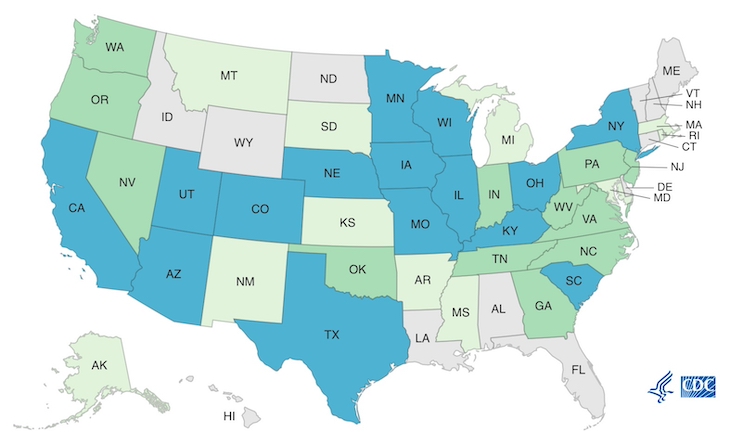Cantaloupe Salmonella cases have almost doubled, according to the CDC, to 230 sick, an increase of 113 new cases since the last update was issued on November 30, 2023. One new death has been reported, 96 people are hospitalized, and there are four new states in the case count total.

The case count by state is: Alaska (1), Arkansas (1), Arizona (15), California (8), Colorado (8), Georgia (3), Iowa (5), Illinois (11), Indiana (5), Kansas (2), Kentucky (7), Massachusetts (1), Maryland (2), Michigan (2), Minnesota (20), Missouri (14), Mississippi (1), Montana (2), North Carolina (4), Nebraska (7), New Jersey (3), New Mexico (2), Nevada (5), New York (7), Ohio (8), Oklahoma (3), Oregon (5), Pennsylvania (5), Rhode Island (1), South Carolina (6), South Dakota (1), Tennessee (5), Texas (16), Utah (9), Virginia (5), Washington (4), Wisconsin (18), and West Virginia (3). But the multiplier epidemiologists use for Salmonella outbreaks, because many people are not counted in the total, is 30.3. That means there could be almost 7,000 people who are sick.
Minnesota has the most cases with 20, and two deaths. Wisconsin is next with 18 patients, Texas has 16, Arizona 15, Missouri has 14 patients, and Illinois has 11. The new death is from Oregon.
Illness onset dates range from October 16, 2023 to November 20, 2023. The patient age range is from less than one year to 100. Of 185 people who gave information to public health investigators, 96, or 52%, have been hospitalized. This is more than double the typical hospitalization rate for Salmonella outbreaks.

Food Safety Attorney and Food Poisoning Bulletin Publisher Eric Hageman
Noted food safety lawyer Eric Hageman, who has successfully represented many people in Salmonella and families in wrongful death lawsuits, said, “This outbreak is exploding, and will probably continue to grow. Please don’t eat cantaloupe unless you are absolutely sure of the brand name and where it came from.”
Investigators have interviewed people about what they ate before they got sick. Of the 105 people interviewed, 74% reported eating cantaloupe, which is significantly higher than the 19.6% of respondents who said they ate that fruit in the FoodNet Population Survey. Of the 78 people who ate cantaloupe, 42 specifically reported eating precut cantaloupe.
Twenty-four patients lived at long term care facilities when they got sick. Of 12 interviewed, nine said they ate cantaloupe. Twenty-three children attended childcare centers when they got sick. Of 20 children with information, 13 ate cantaloupe. The CDC is advising facilities that care for people at highest risk, including long term care centers, childcare centers, hospitals and schools, to not serve any cantaloupe that was supplied pre cut if they don’t know the type of cantaloupe used.
There have been many recalls of Malichita and Rudy cantaloupe by Trufresh issued in relation to this outbreak, including whole cantaloupe, cut cantaloupe products, and some items made with pineapple. Please check to see if you have any of these products in your home. If you froze some for later use, discard them.
Symptoms of Salmonella food poisoning usually appear within a few days, but some people may not get sick until a week has passed after the initial infection. Symptoms include a fever, headache, chills, nausea, stomach pain, vomiting, abdominal pain and cramps, and diarrhea that may be bloody.
If you have eaten cantaloupe and have been sick with these symptoms, see your doctor. You may be one of the cantaloupe Salmonella cases in this outbreak.

If you or a family member have been sickened with a Salmonella food poisoning infection after eating cantaloupe, please contact our experienced attorneys for help with a possible lawsuit at 1-888-377-8900 or text us at 612-261-0856. Our firm represents clients in lawsuits against grocery stores, restaurants, and food processors, and families in wrongful death cases.




